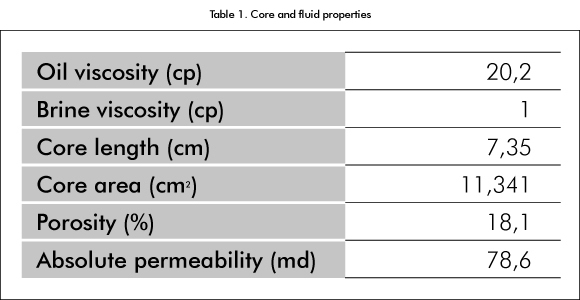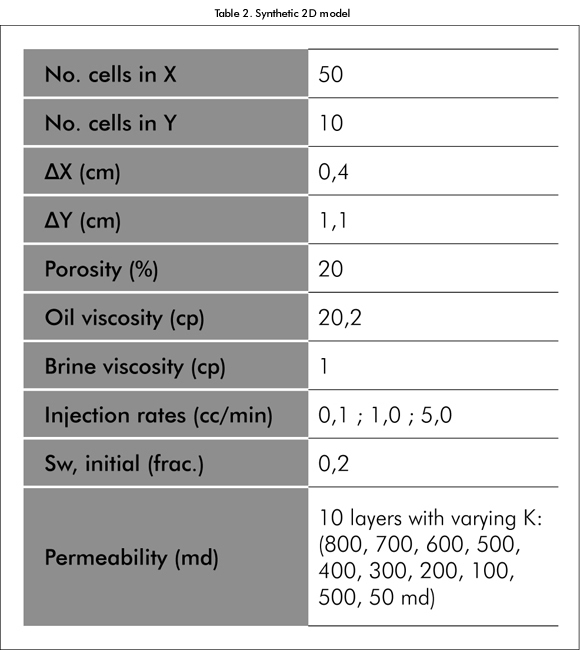Services on Demand
Journal
Article
Indicators
-
 Cited by SciELO
Cited by SciELO -
 Access statistics
Access statistics
Related links
-
 Cited by Google
Cited by Google -
 Similars in
SciELO
Similars in
SciELO -
 Similars in Google
Similars in Google
Share
CT&F - Ciencia, Tecnología y Futuro
Print version ISSN 0122-5383On-line version ISSN 2382-4581
C.T.F Cienc. Tecnol. Futuro vol.2 no.4 Bucaramanga Jan./Dec. 2003
ADJUSTING EXPERIMENTAL SET-UP IMPROVES RELATIVE PERMEABILITY RELIABILITY
Carlos-Humberto Amaya
Ecopetrol S.A. - Instituto Colombiano del Petróleo, A.A. 4185 Bucaramanga, Santander, Colombia
e-mail: caamaya@ecopetrol.com.co
(Received 3 April 2002; Accepted 29 October 2003)
*To whom correspondence may be addressed
ABSTRACT
An improved experimental set-up for relative permeability measurement and interpretation methodology has been developed. The improvement was aimed at two objectives: to modify the equipment in order to obtain more reliable experimental data and to interpret them appropriately. Special emphasis was laid upon pressure drop oscillations and uncertainties in water saturation measurements. Relative permeabilities are inferred by interpreting production data using the JBN method and verifying them by simulation.
RESUMEN
Se realizaron mejoras en el equipo de medición y en el método de interpretación de permeabilidades relativas. Las mejoras fueron dirigidas a lograr dos objetivos: modificar el equipo con el fin de obtener datos experimentales más confiables e interpretarlos apropiadamente. Se prestó especial atención a las oscilaciones en el diferencial de presión y a las incertidumbres en las mediciones de saturación de agua en la muestra de roca. Las permeabildades relativas son inferidas mediante interpretación de los datos de producción del experimento usando el método JBN y verificándolos mediante simulación.
RESUMEN
Foram realizadas melhoras no equipamento de medição e no método de interpretação de permeabilidades relativas. As melhoras foram dirigidas a conseguir dois objetivos: modificar o equipamento com o fim de obter dados experimentais mais confiáveis e interpretá-los apropriadamente. Prestou-se especial atenção às oscilações no diferencial de pressão e às incertezas nas medições de saturação de água na amostra de roca. As permeabilidades relativas são inferidas mediante interpretação dos dados de produção do experimento usando o método JBN e verificando-os mediante simulação.
Keywords: relative permeability, two-phase flow in porous media, waterflooding, core-flooding simulation.
INTRODUCTION
Reservoir engineering studies rely heavily on measurements from a few small samples from reservoir rock formations. Core plug relative permeability is a key measurement since it gives one of the few insights into multiphase flow behaviour. The estimation of reserves and recoverable hydrocarbons for a whole field may depend quite strongly on the values determined for end point saturations and relative permeability curves from this limited core data set. The correct interpretation of such data is therefore crucial.
To find oil and water relative permeability by the displacement or unsteady-state method (Buckley and Leverett, 1942; Rapoport and Leas, 1953), a small linear core plug usually is saturated with water, then oilflooded to irreducible water saturation. Subsequently, the core is waterflooded, and during the process, pressure drop across the entire core and water injection rate are determined. Effluent fractions are collected and the amount of water and oil in each is measured. Augmented by the absolute permeability and pore volume of the core and by oil and water viscosities, these data are sufficient to develop relative permeability curves.
Dynamic displacements at reservoir conditions have been used extensively at Ecopetrol - ICP (Osoba and Richardson, 1951; API RP 40, 1988; Jones and Roszelle, 1978) to measure relative permeabilities during the past decade. Results of these tests have contributed significantly to our understanding of the past recovery performance of many reservoirs, and increased our confidence in predictions of their future performance. Nevertheless, it has been recognized the presence of high oscillations in pressure drop across and uncertainties in water saturation inside core samples during water/oil relative permeabilities measurements that endanger data reliability and as a consequence reservoir performance forecasting.
It is argued that such oscillations in pressure drop across the sample are produced because of an improper backpressure regulator arrangement (Exxon Production Research, 2000). The flow of two nearly incompressible fluids through the backpressure membrane produces a pressure oscillation that is translated to the measured pressure drop across the core sample. A modification of the current experimental set-up has been implemented which eliminates pressure drop oscillations.
Moreover, oil and water volumes produced from the core have previously been measured using glass vessels which introduces serious uncertainties in core sample water saturation. A two-phase separator was added to the equipment that is able to measure produced fluid volumes based on water-oil interface level. This allows continuous measurements of produced fluids with time.
In addition to the improvement in data gathering reliability, a fluid flow simulator is used to verify the experimental production data (pressure drop across the sample and oil production). The added amount of saturation data points allows for the necessary information to simulate the laboratory experiment and confirm the validity of the relative permeability curves estimated by the JBN method (Johnson et al., 1959).
EXPERIMENTAL EQUIPMENT
Figure 1 shows a sketch of the experimental equipment. The main parts of the modified apparatus are a pumping system, a two-phase separator and a core holder.
The pumping system was enhanced by appending four fluid reservoirs, three cylinder pumps and an air-dampened back pressure arrangement that altogether has the capability of recycling one or two phases simultaneously through a core sample. Each phase is pumped into the core sample with accurate and virtually pulse-free flow rates so that oscillation-free pressure drop measurements are expected to be obtained, if the backpressure regulator is adequately arranged.
The backpressure arrangement was emended in such a manner that two-phase flow is prevented from passing through the backpressure membrane. Once fluids have been segregated by means of a gravity separator, one of the two fluids is allowed to flow into a cylinder filled with air and pressurised at the backpressure setpoint. In this way, only air is flowed through the backpressure membrane. In that a single gas phase is flowing and it is compressible, oscillations in differential pressure are suppressed.
Also, a two-phase acoustic fluid level monitor and gravity separator was added to the experimental equipment, which is able to separate water from oil and measure produced fluid volumes based on water-oil interface level. This allows continuous measurements of produced fluids with time in contrast with the previous method which only allowed measurements at discrete points.
The pumping system, the separator and the core holder, all placed in a heating cabinet, provide a closed loop for recycling both phases up to reservoir conditions. The apparatus is capable of running, either, steady-state type experiments and unsteady-state type experiments (i.e., either one or two phases can be simultaneously injected into the core sample). Monitoring of the apparatus and data acquisition is automated and performed using a personal computer.
In addition to the improvement in data gathering reliability, a conventional black-oil fluid flow simulator is used to verify the data. The laboratory test is simulated, with the JBN-derived relative permeabilities as input, to confirm the experimental production data.
EXPERIMENTS AND SIMULATION EVALUATION
In order to examine the effect of the proposed reform on the estimated relative permeability data, two experiments were carried out on the same core sample. A Berea core plug with properties given in Table 1 was used experiment 1 was carried out in the new experimental design and experiment 2 in the previous equipment.
The core sample was vacuum saturated with synthetic brine. Then irreducible water saturation was established by displacing refined oil. And finally, the sample was waterflooded and the production data, pressure drop and produced fluid volume, gathered.
Figure 2 likens current pressure drop data across the sample versus previous data. As observed, oscillations in differential pressure are utterly suppressed.
Figure 3 compares current versus old measurements of produced oil volume. A continuous measurement is achieved which provide us with sufficient information for relative permeability data interpretation. Also, accuracy is increased since the acoustic separator has ±0,1 ml resolution with a ±0,1% uncertainty as opposed to visual measurements with a ±2% uncertainty.
Relative permeabilities were estimated using the JBN method and then validated by simulating the experiments. Figure 4 presents a comparison between the relative permeabilities curves estimated from the two experiments.
A difference greater than 5% is observed in irreducible water saturation and residual oil saturation. As stated above, the uncertainty in volume measurements taken by the acoustic separator is far lower than the one of visual readings on calibrated glass vessels, therefore, the end-points on the relative permeability curves for the second experiment are considered "more correct."
The lower water relative permeability values for the first experiment in spite the higher pressure drop at the end of the experiment is explained by realising its higher residual oil saturation. A higher residual oil saturation means smaller flow area, which increases flow restriction and results in higher differential pressure.
A core model representing the properties and conditions of each experiment, with its respective estimated Kr as input, was loaded in a black-oil simulator and the experimentally obtained data compared with those calculated by using simulation. Figure 5 compares the simulated data and the experimental data obtained in the experiment 1. Figure 6 compares the simulated data and the experimental data obtained in the experiment 2. An improvement in the history match of the experimental data gathered in the new equipment design is observed.
Although an improvement in data quality has been managed, there is the need to enhance the interpretation technique. Adjustment techniques that infer relative permeabilities for the whole saturation range from the adjustment of experimental and simulated production data, in addition to including capillary pressure effects, have been developed lately. It is, therefore, advisable to implement one of such techniques so as to improve the overall process of obtaining reliable relative permeability data.
To further demonstrate how differences in estimated Kr data influence predicted production data, a 2D core model (Table 2) with three injection steps was simulated using the two sets of relative permeability data obtained. The numerical simulator was used to compute pressure drop and produced oil (Figure 7).
Simulation using the Kr data obtained from experiment 2 underpredicts produced oil and gives rise to higher injection well pressure, which clearly is a very pessimistic forecasting.
BIBLIOGRAPHY
API, Recommended Practice. API RP 40, February 1988. [ Links ]
Buckley, S. E. and Leverett, M. C., 1942. "Mechanism of fluid displacement in sands". Trans. AIME, 146, 107. [ Links ]
Exxon Production Research, 2000. "Coring and core analysis course" [ Links ].
Jones, S. C. and Roszelle, W. O., 1978. "Graphical techniques for determining relative permeability from displacement experiments". JPT, 30, 807. [ Links ]
Johnson, E. F., Bossler, D. P. and Naumann, V. O., 1959. "Calculation of relative permeability from displacement experiments". Trans., AIME 216, 370-72. [ Links ]
Osoba, J. S. and Richardson, J. G., 1951. "Laboratory measurements of relative permeability". Trans., AIME 192, 47-56. [ Links ]
Rapoport, L. A., and Leas, W. J., 1953. "Properties of linear waterfloods". Trans. AIME, 198, 139. [ Links ]























